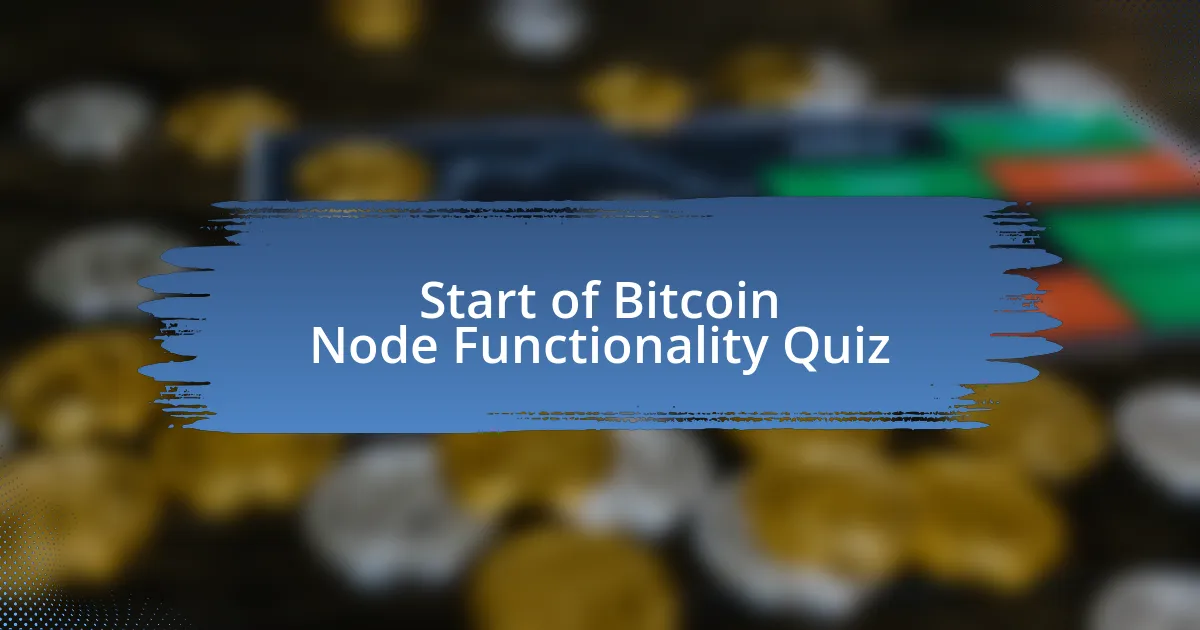
Start of Bitcoin Node Functionality Quiz
1. What is the primary function of Bitcoin nodes in verifying transactions?
- Only confirming the transaction amounts before approval.
- Acting as a wallet to hold Bitcoin funds.
- Storing transaction data for future reference.
- Verifying the authenticity of the sender, ensuring the transaction adheres to the Bitcoin protocol rules, and checking if the sender has sufficient funds.
2. What does a Bitcoin node store?
- A complete copy of the blockchain.
- A list of all Bitcoin wallets.
- The transaction fees for each block.
- All private keys of users.
3. How do Bitcoin nodes facilitate the dissemination of transaction data?
- By broadcasting transaction information to other nodes.
- By requiring user verification before sharing data.
- By encrypting transaction data for privacy.
- By storing transaction data on a central server.
4. What is the role of a Bitcoin node in maintaining the integrity of the system?
- Preventing double-spending by verifying transactions.
- Monitoring network speed and optimizing bandwidth use.
- Collecting user personal data for service improvements.
- Facilitating all cryptocurrency exchanges between wallets.
5. What is the purpose of storing the blockchain in Bitcoin nodes?
- To increase the speed of transaction processing and confirmation.
- To store user personal information for transaction history.
- To allow miners to gain rewards for each block added to the blockchain.
- To enable new participants to synchronize with the network and validate transactions independently.
6. How do Bitcoin nodes contribute to decentralization?
- By directly managing user accounts and funds effectively.
- By ensuring no single entity controls the entire network, promoting transparency and security.
- By processing transactions more quickly than centralized systems.
- By providing a user-friendly interface for mass adoption.
7. What happens when a new transaction occurs in the Bitcoin network?
- The transaction is propagated to neighboring nodes, which then spread the information across the network.
- The transaction gets stored in the miner`s wallet for later use.
- The transaction is deleted if it doesn`t meet the network`s requirements.
- The transaction is immediately confirmed and added to the blockchain.
8. What are the benefits of running a Bitcoin node?
- It stores personal data of users for security.
- It allows users to create new cryptocurrencies.
- It contributes to the overall health and resilience of the network.
- It increases transaction fees for users.
9. What is the primary responsibility of Bitcoin nodes in validating transactions?
- Mining new blocks to add to the blockchain.
- Verifying the authenticity of the sender and ensuring the transaction adheres to the Bitcoin protocol rules.
- Storing transaction data in a decentralized manner.
- Checking the IP address of the sender for security purposes.
10. How do Bitcoin nodes check if a sender has sufficient funds for a transaction?
- By verifying that the sender has sufficient funds to complete the transaction.
- By checking the transaction ID against a central database.
- By observing the sender`s account history for activity.
- By requiring a signature from the recipient`s wallet.
11. What is the purpose of broadcasting information in Bitcoin nodes?
- To store all user personal information for future reference.
- To restrict access to certain transactions based on user identity.
- To process transactions immediately without confirmation from other nodes.
- To facilitate the efficient dissemination of transaction data across the network.
12. What happens if a transaction passes the initial test in a Bitcoin node?
- The transaction is added to the mempool.
- The transaction is immediately confirmed.
- The transaction is sent to a central server.
- The transaction is discarded as invalid.
13. What is the role of miners in relation to Bitcoin nodes?
- Miners verify the transactions in the blockchain.
- Miners communicate directly with wallet services for transaction approval.
- Miners store the blockchain locally on their devices.
- Miners aggregate transactions into blocks and search for a proof-of-work solution.
14. What does a miner do after finding a valid block?
- The miner sends the block to a central server for approval.
- The miner deletes the block and starts over.
- The miner broadcasts the solution to the network, and nodes verify the miner’s work.
- The miner keeps the block secret to gain an advantage.
15. What happens if a block is approved by nodes?
- Nodes update their ledger copy and pass along the change to their connected peers.
- Nodes ignore the block and continue as before.
- Nodes create a new algorithm and restart the network.
- Nodes delete the previous block and stop all transactions.
16. What are the main types of Bitcoin nodes?
- Guardian nodes, ghost nodes, shadow nodes, and relay nodes.
- Full nodes, super nodes, light nodes, and mining nodes.
- Core nodes, backup nodes, relay nodes, and proxy nodes.
- Standard nodes, verification nodes, master nodes, and blockchain nodes.
17. What is the primary function of full nodes in the Bitcoin network?
- Storing only the most recent block data.
- Connecting users with wallet services.
- Ensuring that every block follows the Bitcoin protocol rules.
- Mining new blocks to earn rewards.
18. What do full nodes check in a new block?
- They verify that the new block chains to the previous block, all transactions are legitimate, and the new block hash is less than the target.
- They monitor network traffic and allocate bandwidth to nodes.
- They only check the timestamp and miner`s address in the block.
- They confirm the price of Bitcoin at the time of block creation.
19. What happens if a transaction is added to the mempool?
- The transaction is discarded immediately to save resources.
- Miners select transactions from the mempool based on their attractiveness (highest fees).
- The transaction is automatically included in the next block.
- The transaction is stored indefinitely without any action.
20. How do miners choose which transactions to include in their next candidate block?
- Miners prioritize transactions from well-known users.
- Miners randomly select transactions from the mempool.
- Miners only choose transactions based on their age.
- Miners generally include transactions with the highest fees first.
21. What is the role of a pruned node in the Bitcoin network?
- A pruned node exclusively mines new blocks and secures the network.
- A pruned node stores a complete copy of the blockchain for reference.
- A pruned node only uploads data to other nodes without validation.
- A pruned node downloads and validates transactions but does not upload data to the network.
22. How do pruned nodes verify transactions?
- They verify transactions but do not upload data to the network.
- They share all transaction data with the network.
- They do not verify any transactions at all.
- They only download transactions without validation.
23. What is the purpose of a Merkle root in a Bitcoin block header?
- The Merkle root is included in the block header to efficiently verify the validity of transactions in the block.
- The Merkle root is used to encode the miner`s transaction fees.
- The Merkle root specifies which miner created the block.
- The Merkle root stores the IP addresses of all network nodes.
24. What is the purpose of the difficulty target in a Bitcoin block header?
- The difficulty target dictates the maximum transaction fees per block.
- The difficulty target ensures that the block hash is less than the target, requiring sufficient proof-of-work.
- The difficulty target sets the time limit for completing transactions.
- The difficulty target establishes a fixed block size requirement.
25. What is the purpose of the nonce in a Bitcoin block header?
- The nonce is used to encrypt transaction data in the block.
- The nonce is used to designate the block creator`s identity.
- The nonce is used to store the previous block`s hash.
- The nonce is used to find a valid block hash that meets the difficulty target.
26. How do Bitcoin nodes check if a transaction is valid?
- They check the blockchain for previous blocks and validate the user`s email.
- They ensure the transaction amount matches the local currency exchange rate.
- They verify that the transaction data is formatted correctly, is less than the block limit, and conforms to other technical parameters.
- They confirm the identity of the user using biometric data.
27. What happens if a node receives a new block?
- The node immediately adds the block to its chain without checks.
- The node sends the block to all connected nodes without verification.
- The node performs standard checks on the transactions in the block, including verifying the block header and Merkle root.
- The node discards the block if it doesn`t match the previous hash.
28. What is the purpose of signature validation in Bitcoin nodes?
- To ensure that the signature matches the sender’s public key.
- To verify the transaction amount is correct.
- To confirm the transaction is against the rules.
- To check the age of the transaction.
29. What do nodes check when validating a transaction?
- The time of transaction creation.
- The transaction amount limit.
- The transaction sender`s identity.
- The unlocking and locking scripts.
30. What is a UTXO (Unspent Transaction Output)?
- A record of a confirmed transaction that is no longer valid.
- A pending transaction waiting to be verified by miners.
- An input that has already been spent and cannot be reused.
- An output of a transaction that can be spent as an input in a new transaction.

Quiz Completed Successfully!
Congratulations on completing the quiz on Bitcoin Node Functionality! You’ve taken an important step in understanding how Bitcoin operates. Throughout this quiz, you’ve likely gained insights into the crucial role nodes play in the Bitcoin network. Understanding the differences between full nodes and lightweight nodes is essential. You’ve also learned how nodes contribute to network security and transaction validation.
It is great to see your enthusiasm for learning about Bitcoin technology. Engaging with this material helps demystify how cryptocurrencies work. Whether it’s the process of block validation or the importance of decentralized networks, knowledge is power in the crypto space. Each question provided a chance to reflect on these concepts, enhancing your understanding.
To reinforce what you’ve learned, I invite you to explore the next section on this page. It delves deeper into Bitcoin Node Functionality, offering valuable information that can build upon your quiz experience. Discover more about how to set up your own node, or understand its implications for privacy and security. Your journey in mastering Bitcoin has only just begun!

Bitcoin Node Functionality
Overview of Bitcoin Nodes
Bitcoin nodes are computers running the Bitcoin software, which participate in the Bitcoin network. They validate transactions and blocks, share information, and maintain a copy of the blockchain. Nodes play a crucial role in ensuring the integrity and decentralization of the Bitcoin network. There are different types of nodes, including full nodes and lightweight nodes, each serving specific functions.
Functions of Full Nodes
Full nodes store the entire blockchain and enforce the rules of the Bitcoin protocol. They validate all transactions and blocks according to consensus rules. By doing this, they help prevent double spending and maintain overall network security. Full nodes also relay verified transactions and blocks to other nodes, contributing to network propagation.
Lightweight Nodes and Their Limitations
Lightweight nodes, or SPV (Simplified Payment Verification) nodes, do not store the entire blockchain. Instead, they rely on full nodes for transaction verification. This makes lightweight nodes more resource-efficient but also less secure. They cannot independently validate transactions and blocks, which may expose them to potential risks, such as relying on potentially malicious full nodes.
The Importance of Node Diversity
Node diversity ensures a robust and resilient Bitcoin network. Different types of nodes, located in various geographic regions, contribute to decentralization. Diverse nodes reduce the risk of censorship, attack, or failure of the network. A healthy distribution of full and lightweight nodes enhances overall network stability and security.
Running a Bitcoin Node: Requirements and Benefits
Running a Bitcoin node requires adequate hardware, a stable internet connection, and sufficient storage to accommodate the blockchain. The benefits include contributing to network security, gaining independence from third-party services, and having access to the entire transaction history. Additionally, running a node allows users to validate their own transactions, offering greater privacy and control.
What is the functionality of a Bitcoin node?
A Bitcoin node is a computer that participates in the Bitcoin network by validating transactions and blocks. It ensures that all transactions adhere to Bitcoin’s consensus rules. Nodes maintain a copy of the entire blockchain and broadcast new transactions and blocks to other nodes. This process secures the network and helps prevent fraud and double-spending.
How do Bitcoin nodes validate transactions?
Bitcoin nodes validate transactions by checking them against the blockchain’s consensus rules. This includes verifying that the digital signatures are correct and that the sender has sufficient funds. Transactions that meet these criteria are marked as valid and propagated through the network. According to Bitcoin’s protocol, these checks ensure that only legitimate transactions are added to a block.
Where do Bitcoin nodes store data?
Bitcoin nodes store data locally on their hard drives. They maintain a complete copy of the blockchain, which is a distributed ledger of all Bitcoin transactions. The blockchain can grow in size over time, currently exceeding 400 gigabytes. Nodes synchronize their data with other nodes to ensure consistency across the network.
When do Bitcoin nodes receive updates?
Bitcoin nodes receive updates when new blocks are mined and added to the blockchain. This occurs approximately every 10 minutes, depending on mining activity. Nodes continuously listen for new transactions and blocks broadcasted by other nodes, updating their local copies of the blockchain accordingly. This process maintains the network’s current state and validity.
Who operates Bitcoin nodes?
Bitcoin nodes can be operated by anyone with access to a computer and an internet connection. This includes individual users, businesses, and organizations interested in participating in the Bitcoin network. The operation of nodes is crucial for the decentralization of the network, as more nodes enhance security and reliability. As of 2023, there are thousands of active nodes worldwide contributing to the network.


